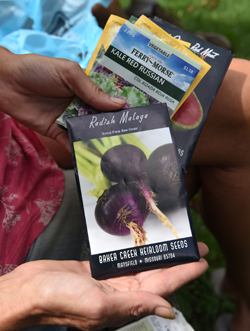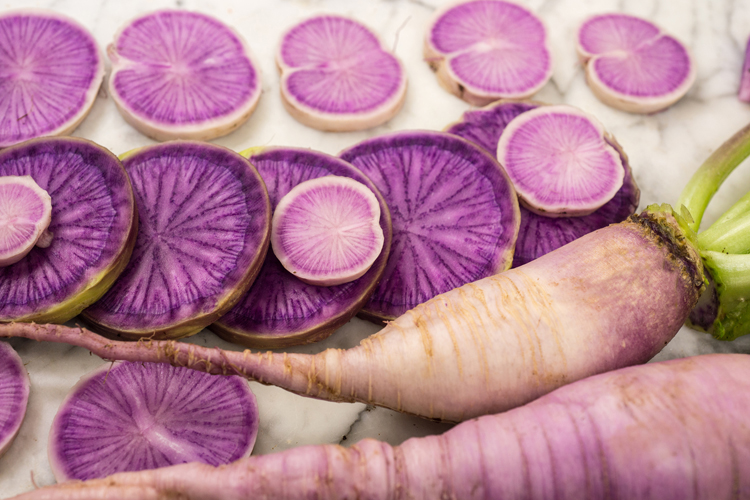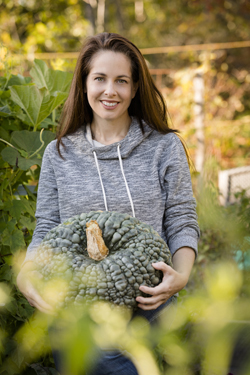Plant cool weather veggies now
Posted on: August 31, 2017 | Written By: Doug Oster |
Most gardeners cuddle up with their seed catalogs in January dreaming of spring, but Karin Eller, of Plant-It Earth Greenhouse near Homer City, waits until July, when she gets a break from the busy season, to search for new varieties to plant in the late summer and fall.
Gardening doesn’t have to stop as the season fades, there’s still plenty of time to plant a garden that will provide fresh produce into winter.

Karin Eller, owner of Plant-It Earth Greenhouse near Homer City, sits in front of the garden filled with fall crops.

Karin Eller, owner of Plant-It Earth Greenhouse near Homer City, holds seed packets of plants that will planted for the fall and winter garden.
Eller has run Plant-It Earth Greenhouse (724-479-0808 or Plant It Earth) with husband Larry for the past 21 years and is entering her seventh as a fall vegetable gardener. Their huge garden is 30 by 130 feet and not only supplies produce for customers, but also for their own table.
They began with radishes and lettuce the first year, but now she has a plethora of different veggie seeds for planting.
“I’m trying watermelon radishes and a radish from India; it’s purple and it’s very heat tolerant,” Eller says.
The nights are cool, but days can still be hot, so choosing varieties that are best for the fall is imperative. The ‘Pusa Jamuni’ radish has streaked lavender, dark purple flesh from the skin all the way to the center. Another interesting variety is ‘Malaga’ from Poland. It boasts purple skin with pure white flesh and is ready to harvest in a little over a month.
“They looked interesting in the seed catalog and it’s just a nice color to have,” she says.
The garden also will be planted with kohlrabi, cabbage, cauliflowers, Swiss chard, parsnips, spinach, arugula, turnips, rutabagas and much more. About 50 percent of the fall garden is in place, but she’s still waiting for things to cool down a little bit before planting head lettuce and some other cold weather greens.
She’s found that the pests are greatly reduced this time of the year and the upcoming cooler weather won’t bother these crops. “By the time your plant is big enough, it can take the frost,” she says.

Radish ‘Pusa Jumani’ is from India and one of the interesting varieties Karin Eller of Plant-It Earth Greenhouse is growing for a fall harvest. Photo courtesy Baker Creek Heirloom Seeds.
Eller actually started her first sowing of peas, carrots and zucchini the third week of July. The zucchini will last until frost, peas a little longer and the carrots will be dug all winter from under a thick layer of mulch.
Other vegetables she’s planting:
Rutabagas: Eller says they are wonderful after a hard frost. “They get huge and are great for storage, you can have something fresh from your garden in February, which is so nice,” she says.
Chinese kale and different Asian greens: She’s never grown theses seeds before, but “I wanted to experiment this year, I’m a garden junkie,” she says with a chuckle.
Winter lettuce: It can actually freeze solid and then thaw fine. “Marvel of Four Seasons,’ ‘Red Flame,’ ‘Lolla Rossa’ and one with the best name ever, ‘Drunken Woman Frizzy Headed Lettuce’ are all cold tolerant.
“I’m going to keep it going as long as possible,” she says of the fall and winter garden. “It’s more laid back, where you can really enjoy it, you can go out see what it’s doing, take your time, get a breath and go work in the garden.”
Period of rejuvenation

Niki Jabbour is author of The Year Round Vegetable Gardener and writer for the award winning Savvy Gardening blog. She loves planting for a fall and winter harvest. Many of the crops she plants during the late summer will survive through the cold and can be harvested in the spring.
Niki Jabbour’s foray into fall growing came by accident after harvesting arugula in late summer and discovering the plants had regrown by October. “It just snowballed from there,” she says.
“By late summer, people might be done. For me it’s a period of rejuvenation. If you love to garden, this is a fabulous time to get out to extend your season for as long as possible,” says the Halifax, Nova Scotia, author of “The Year Round Vegetable Gardener” and writer for the award-winning Savvy Gardening blog.
And what’s going into her garden?
Kohlrabi: She’s got transplants of ‘Purple Vienna’ kohlrabi that will go in soon, along with some winter cabbage and broccoli.
Kale: “Don’t be shy about experimenting with kale,” she says. “A lot of them have different textures, different colors. ‘Russian Frills’ is really pretty and has very airy, super serrated leaves which are beautiful and delicious.” She scatters the seed on a bed and thins as needed. It produces baby kale, which she says is the best tasting way to use the vegetable.
Other leafy greens: Things like tatsoi and komatsuna might have unfamiliar names, but there’s a whole group of these plants that offer interesting flavor profiles, love cool weather and are easy to grow from seed. “Grow some things you already like, but don’t be afraid to try some of the other different greens. I love a lot of the loose leaf Asian cabbages,” she says.
Turnips: “They are a very unsexy vegetable,” she says with a laugh. “The leaves are awesome, they are a great fall and winter green. They’re cold tolerant and delicious. You can stir fry them, saute them or chop them up and drizzle them with a little bit of salad dressing.”
Beets and radishes: Beets can be planted now, along with variety of different radishes.
Jabbour practices succession planting even for her fall crops, planting corn mache and other greens every two weeks until it gets really cold.
She uses cold frames — an unheated greenhouse with a transparent or translucent lid — to keep the plants happy during the hardest parts of winter. Siting the frames to the south and the angling the lid at 35 degrees will best utilize the low winter sun. She also uses hoop houses covered in plastic.
The easiest and cheapest way to protect late season plantings is to mulch, she says.
“Take those shredded leaves and use them to insulate crops like leeks, carrots, beets, turnips, rutabagas, radishes, things like that,” she says. “You can extend your season by weeks or months and it doesn’t have to cost you a penny.”
It’s not just in the garden either, Jabbour says. Containers are a great place to grow greens and root crops. “You can even protect them with a tomato cage covered with a plastic bag to create an instant cloche,” she says.
Doug Oster is editor of Everybody Gardens, a website operated by 535Media, LLC. Reach him at 412-965-3278 or doster@535mediallc.com. See other stories, videos, blogs, tips and more at everybodygardens.com.
Sources:
Baker Creek Heirloom Seeds, rareseeds.com or 417-924-8917.
Johnny’s Selected Seeds, johnnyseeds.com or 877-564-6697.
Renee’s Garden, reneesgarden.com or 888-880-7228.